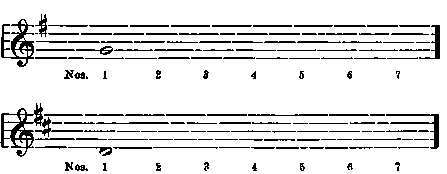Harmony Book For Beginners - online book
Scales, Intervals, Common Chords, Dominant Seventh Chord and Melody Making.
| Share page | Visit Us On FB |
|
OREM'S HARMONY BOOK |
||
|
No. 3 consists of Root, Minor Third, Perfect Fifth. No. 4 " " Root, Major Third, Perfect Fifth. No. 5 " " Root, Major Third, Perfect Fifth. No. 6 " " Root, Minor Third, Perfect Fifth. No. 7 " " Root, Minor Third, Diminished Fifth.
It will be observed that the first six Triads all have Perfect Fifths but that the seventh Triad has a Diminished Fifth. This latter is known as a Diminished Triad because of its diminished fifth. Remember this always.
A further examination of the first six Triads discloses the fact that three of them have Major Thirds and three of them have Minor Thirds. Triads which have Major Thirds and Perfect Fifths are known as Major Triads; Triads, which have Minor Thirds and Perfect Fifths are known as Minor Triads.
Nos. 1, 4, 5 in any Major Scale are always Major Triads; Nos. 2, 3, 6 in any Major Scale are always Minor Triads.
Play these Major Triads from the Scale of C Major again and again. Try to recognize them when heard.
Major Triads in C Major |
||
|
|
||
 |
||
|
|
||
|
Nos. 14 5
Compare with these the Minor Triads, Nos. 2, 3, 6. |
||
|
|
||
 |
||
|
|
||
|
Nos. 2 3 6
Play these also many times over and learn to recognize them.
Finally play No. 7 with its Minor Third and Diminished Fifth. Note how different from the others and never forget it.
Diminished Triad |
||
|
|
||
 |
||
|
|
||
|
No. 7 These seven Triads are found in the same form and order in every Major Scale. Let us write them all out, as before, number and mark them.
Major Minor Minor Major Major Minor Diminished |
||
|
|
||
 |
||